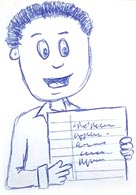Rates of Chemical Change
Key Words
Rate of reaction – how fast the reactants are changed into products. This depends on:
- Temperature
- Concentration of solution or pressure of gas.
- Suface area
- Catalyst
Collision frequency – how often they colide.
Activation energy – minimum amount of energy that particles need to react.
Reversible reactions – reactions that can go backwards.
Equilibrium – forward reactions go at the same rate as backward reactions
Dynamic equilibrium – forward and backward reactions are taking place but with no overall effect.
Closed system – none of the reactants or products can escape and nothing else can get in.
Position of equilibrium – if it lies to the right the concentration of products is greater than the reactants. If it lies to the left the concentration of reactants is greater than the products. Positioning depends on:
- Temperature
- Pressure
- Concentration
Endothermic – energy is transferred from the surroundings.
Exothermic – energy is transferred to the surroundings.
Le Chatelier’s Principle – if you change the conditions of a reversible reaction at equilibrium, the system will try to counteract that change.
PRACTICAL
Rates of Reaction
Watch the video and have a go at writing out the steps of the practical.
Links for Learning
Websites  Videos  Games  Quizzes
BBC Bitesize: Rate of reaction
Chem 4 Kids: Rate of reaction
BBC Bitesize: Measuring rates of reaction
BBC Bitesize: Factors affecting the rate of reaction
BBC Bitesize: Reversible reactions
BBC Bitesize: Reversible reactions & equilibrium
BBC Bitesize: Le Chatelier’s Principle

Find out what kind of learner you are and the best revision techniques for you.
Visit our Revision Tips page for more.


